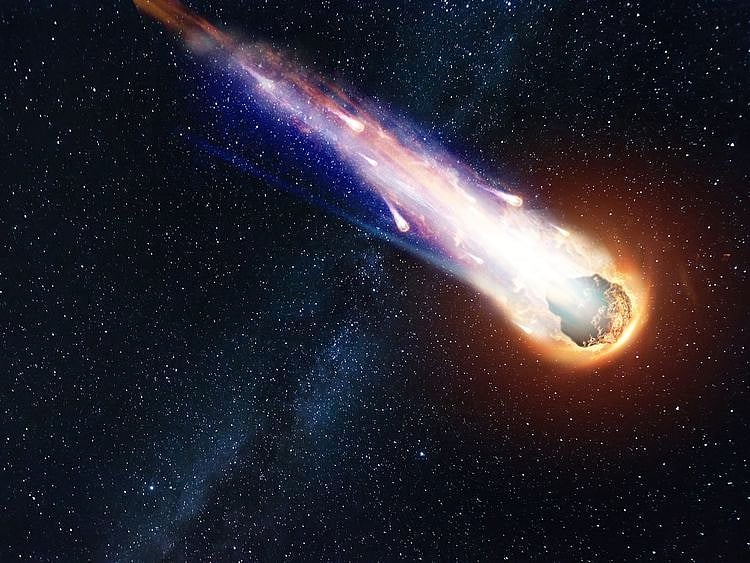Confirmed: First interstellar meteor to hit Earth
US military confirms first known interstellar meteor to hit our planet

Top secret documents from the US Space Command have finally revealed details of a mysterious object that blazed over Papua New Guinea eight years ago.
On January 8, 2014, the meteor known as CNEOS 2014-01-08 crash-landed along the northeast coast of Papua New Guinea, the US Space Command document has confirmed.
It was the first known “interstellar meteor” to ever hit the Earth that scientists discovered.
The finding, and confirmation from the US Space Command, was reported by CNN on Thursday (April 14). The trail of information goes back to a 2019 study, when researcher Amir Siraj identified the object as an interstellar meteor. He had coauthored the study as an undergraduate student at Harvard.
Siraj was working with Harvard University's Abraham Loeb, a professor of science, to investigate “Oumuamua” — the solar system’s first known interstellar object discovered, it added.
What is an interstellar meteor?
An interstellar meteor is a space rock that originates from outside our solar system — which is a rare occurrence.
Loeb and Siraj were unable to publish their findings in a scientific journal because their data came from NASA's CNEOS database — which does not include information such as the accuracy of the measurements.
After years of trying to obtain details, they finally received official confirmation from John Shaw, the deputy commander of the US Space Command — that it was, in fact, an interstellar meteor.
Oumuamua
ʻOumuamua is a known interstellar object detected passing through the Solar System. It is possibly the second interstellar object known; the first being a purported interstellar meteor that impacted Earth in 2014.
It was not clear when the confirmation was given, though the CNN ran the story on Thursday (April 14, 2022).
Confirmed by US Space Command
“Dr. Joel Mozer, the Chief Scientist of Space Operations Command, the United States Space Force service component of US Space Command, reviewed analysis of additional data available to the Department of Defense related to this finding. Dr Mozer confirmed that the velocity estimate reported to NASA is sufficiently accurate to indicate an interstellar trajectory,” Shaw wrote in his letter.
The command is a part of the US Department of Defense and is responsible for military operations in outer space.
Siraj decided to go through NASA's Centre for Near Earth Object Studies database to find other interstellar objects and found what he believed to be an interstellar meteor within days.
Need for speed
The meteor's high velocity is what initially caught Siraj's eye. The meteor was moving at a high speed of about 45km per second relative to Earth, which is moving at around 30km per second around the sun.
Scientific American reported that the confirmation of the calculations and the interstelar origins of the high-speed struck the Earth in 2014 was aided by spy satellites.
Due to the fact that researchers measured how fast the meteor was moving while on a moving planet — the 45km per second was not actually how fast it was going.
“Heliocentric speed”
The heliocentric speed is defined as the meteor's speed relative to the sun, which is a more accurate way to determine an object's orbit.
It’s calculated based on the angle at which a meteor hits the Earth.
The planet moves in one direction around the sun, so the meteor could have hit Earth head-on, meaning opposite the direction the planet is moving — or from behind, in the same direction the Earth is moving.
Since the meteor hit the Earth from behind, Siraj's calculations show the meteor was actually travelling at about 60km per second relative to the sun.
He then mapped out the trajectory of the meteor and found it was in an unbound orbit, unlike the closed orbit of other meteors.
This means that rather than circling around the sun like other meteors, it came from outside the solar system.
“Presumably, it was produced by another star, got kicked out of that star's planetary system and just so happened to make its way to our solar system and collide with Earth," Mr Siraj said.
Difficulty getting published
“Dr Mozer confirmed that the velocity estimate reported to NASA is sufficiently accurate to indicate an interstellar trajectory.”
“I thought that we would never learn the true nature of this meteor, that it was just blocked somewhere in the government after our many tries, and so actually seeing that letter from the Department of Defence with my eyes was a really incredible moment,” Siraj said was quoted by CNN.
A second chance
Since receiving the confirmation, Siraj said his team is working to resubmit their findings for publication in a scientific journal.
Siraj would also like to put a team together to try and retrieve part of the meteor that landed in the Pacific Ocean but admitted it would be an unlikely possibility due to the sheer size of the project.
If researchers were able to get their hands on the “holy grail of interstellar objects,” Siraj said it would be scientifically groundbreaking in helping scientists discover more about the world beyond our solar system.
Network Links
GN StoreDownload our app
© Al Nisr Publishing LLC 2025. All rights reserved.